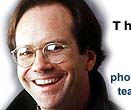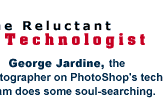


|
|

|
|
| HOME | INFOTECH | HEADLINES | |||
| June 16, 1998 |


Patterns in the DNA weaving, sand-dune building and supernova-firing nature. Patterns in the space shuttle igniting, bicycle pedalling, software writing technology. And patterns in the hip thrusting, fret board slipping, brush wielding world of art. It is the pursuit of these patterns that will drive humanity through the second renaissance, which will result from the Information Age. When we will move on from building cranes and planes to building tools that will mimic the patterns of the mind. And this will call on thousands of renaissance people to fuel a culture that will match the shine on their spaceships. For instance, it will surely call on people like George Jardine, the digital video evangelist with Adobe, the American software company. Jardine is a reluctant technologist. He would rather be an artist. Yet the irony is that he joyfully made a transition from the world of photography, which is closer to art, to the world of software, which is closer to technology! People like Jardine understand patterns wherever they encounter them. Pigments or pixels do not matter; their trip lies in the essence of the patterns they form. Most importantly, it does not matter whether those patterns are formed on a computer screen or in the elegance of software code, whirring off a hard disk. "I am a toy freak, a technology freak," he explains to Rediff readers in this interview with Priya Ganapati as he traces the development of a small utility software that grew into the power tool people call Photoshop. Excerpts: You are a digital video evangelist for Adobe Systems. What exactly do you do?
There are a number of roles for an evangelist. One is to write tips and techniques for the Web. Another is to meet with high-end users and give them a non-sales talk. That is, tell them about the product without all the sales hype and hand out tips and techniques to enhance the maximum possibilities of the package. We access high-end users, talk to them, find out what they think about the product, what they want out of the product and bring that information back to the product marketing managers and engineers who will then work to improve the product. What has been your role in the development of Adobe Photoshop? It is a CD product with a lot of additional tips and techniques. It has a lot of ancillary peripheral work in it that provides feedback and input on interface issues. Photoshop is a team effort with the product managers, marketing managers and engineers working on it. We (the evangelists) go see customers and bring back their feedback, which is used to improve the product. How many people are on the team developing Photoshop? There are a lot of people contributing to the programme with lots of ideas. But yes, there are a few who are working harder than the others to see that the product is a success. The senior engineers, products marketing managers, have a heavier rating than the others do. Basically, it is a team effort. As the company gets bigger, we have broader issues and more people working to make the product better. I always say this in my teaching workshops: The newest feature of Photoshop is the one you asked for and we delivered. How did Photoshop evolve? They sold the software to Barneyscan, which was shipping it with its scanners as utilities to access their scanners. Adobe recognised the potential of the product, which had bitmap editing ability and purchased the technology in 1988. In itself, Photoshop is probably the private vision of two people. Can you tell us how Photoshop evolved into its present form? Photoshop version 2.5 was out a couple of years later in '92. It brought in 'quick mask' and a whole bunch of new filters. Photoshop 3.0 was a revolution in the product in terms of 'layers' and the 'apply image' commands. I have been working for Adobe for four years and Photoshop 3.0 was my first project. Photoshop 4.0, released in 1996, was a significant effort to bring about interfacing with the rest of the products in terms of actions that helped make the programme 'automatable'. Photoshop 4.0 helped to integrate the production line in terms of keystrokes and palettes in conjunction with PageMaker 6.0 and 6.5. Given your background as a professional photographer, would you rather look at Photoshop as a work of art or a product of technology? Every art is shaped by the tools and the methods of the artist. Why has digital art not yet become mainstream? When tools change there is some resistance initially and people don't accept change easily. For example when television was first introduced, television shows were more like televised radio shows. People used to just wear microphones and present things in a radio format. Every time technology changes people try and emulate the past. Your Web site is the best example of how new technology has brought about a change in the way people look at things. It offers interactivity with the readers and the possibility of instant news updates, which a more conventional medium would probably not be able to give. Digital art will open new horizons. In the future it will be a legitimate art form in itself. I think that it is part of the challenge to find out what digital art is capable of and the horizons it opens up to us. Why did you make the transition from being a photographer to a digital video expert? What was it like?
Jerry is the director of the photo programme at the University of Florida. He is a very famous photographer and has recently retired. My background as a photographer allowed me to understand the process very well and help bring together the creative thoughts between us. It was a very gratifying project as I could use my photography background in directing the production of a digital art form. Can you give some specific instances from your experience at Adobe where your background as a photographer helped? How has your sensibility as an artist helped you understand the technology that went towards developing the Photoshop package? But do you think it is possible to create a good design without grasping the technology that goes into it? But in Denver, I also worked with fashion photographers whose technology was terrible but they had great vision. There are no rules. Some people have technology, some vision, rarely both, but it does happen as in case of Jerry Uelsmann. I am fairly impressed with the lack of technical knowledge or savvy that successful photographers like Ansell Adams have. They are driven by a sense of greater vision to express their needs. What have been your experiences in the development of Photoshop? What do you regard yourself to be? A technologist or an artist? What have been your initial experiences when you made the transition from a photographer to a digital art guru? I simply wanted to work with computers because I was fascinated with their potential elegance. |
||||
|
HOME |
NEWS |
BUSINESS |
CRICKET |
MOVIES |
CHAT
INFOTECH | TRAVEL | LIFE/STYLE | FREEDOM | FEEDBACK |
|||||